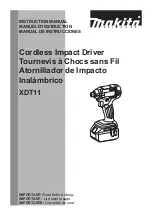
English
6
SPECIFIC SAFETY RULES
1.
Hold tools by insulated gripping surfaces when performing an operation where the
cutting tool may contact hidden wiring.
Contact with a “live” wire will make exposed
metal parts of the tool “live” and shock the operator.
2.
Never touch moving parts.
Never place your hands, fingers or other body parts near the tool’s moving parts.
3.
Never operate without all guards in place.
Never operate this tool without all guards or safety features in place and in proper
working order. If maintenance or servicing requires the removal of a guard or safety
feature, be sure to replace the guard or safety feature before resuming operation of the
tool.
4.
Use right tool.
Don’t force small tool or attachment to do the job of a heavy-duty tool.
Don’t use tool for purpose not intended —for example— don’t use circular saw for
cutting tree limbs or logs.
5.
Never use a power tool for applications other than those specified.
Never use a power tool for applications other than those specified in the Instruction
Manual.
6.
Handle tool correctly.
Operate the tool according to the instructions provided herein. Do not drop or throw
the tool. Never allow the tool to be operated by children, individuals unfamiliar with its
operation or unauthorized personnel.
7.
Definitions for symbols
V ............. volts
---
— ............ direct current
n
o
........... no load speed
---/min .... revolutions or reciprocation per minute
8.
Keep all screws, bolts and covers tightly in place.
Keep all screws, bolts, and plates tightly mounted. Check their condition periodically.
9.
Do not use power tools if the plastic housing or handle is cracked.
Cracks in the tool’s housing or handle can lead to electric shock. Such tools should not
be used until repaired.
10. Blades and accessories must be securely mounted to the tool.
Prevent potential injuries to youself or others. Blades, cutting implements and
accessories which have been mounted to the tool should be secure and tight.
11. Never use a tool which is defective or operating abnormally.
If the tool appears to be operating unusually, making strange noises, or otherwise
appears defective, stop using it immediately and arrange for repairs by a Hitachi
authorized service center.
12. Carefully handle power tools.
Should a power tool be dropped or struck against hard materials inadvertently, it may
be deformed, cracked, or damaged.
13. Do not wipe plastic parts with solvent.
Solvents such as gasoline, thinner, benzine, carbon tetrachloride and alcohol may
damage and crack plastic parts. Do not wipe them with such solvents.
Wipe plastic parts with a soft cloth lightly dampened with soapy water and dry
thoroughly.
Summary of Contents for WH 12DM2
Page 107: ...107 ...







































